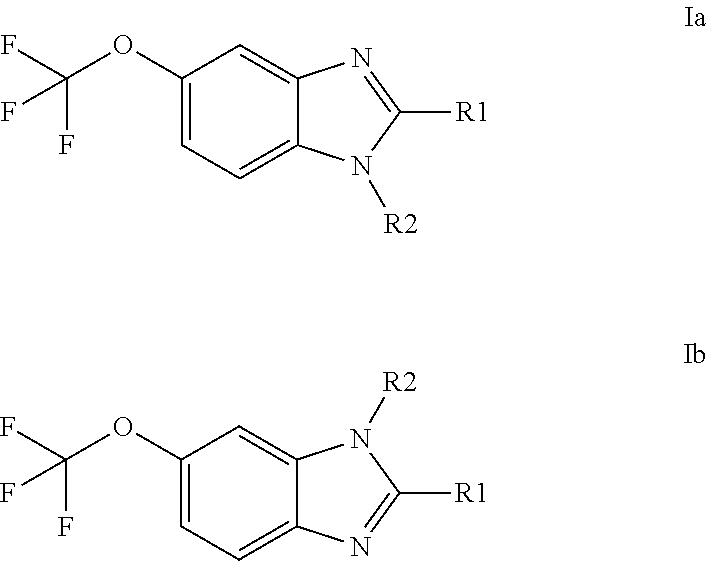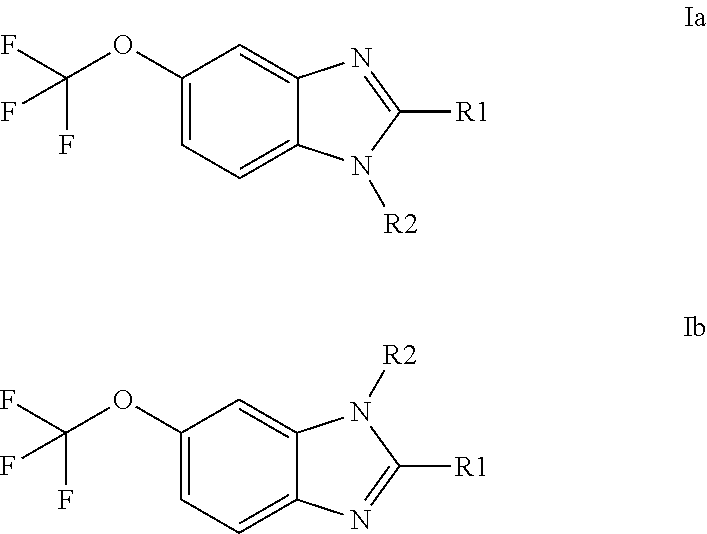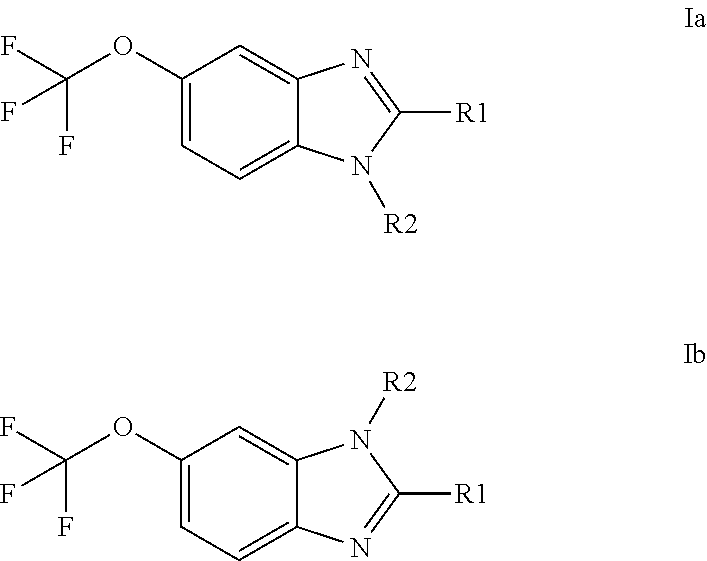Anti-cancer agents based on 6-trifluoromethoxybenzimidazole derivatives and method of making
a technology of 6-trifluoromethoxybenzimidazole and derivatives, which is applied in the field of anticancer agents based on 6-trifluoromethoxybenzimidazole derivatives and the method of making, can solve the problems of not being able to tell whether abiraterone® chemotherapy will have long-term survival benefits, and not being able to directly relate to the use of 6-trifluoromethoxybenzimidazole derivatives for cancer treatmen
- Summary
- Abstract
- Description
- Claims
- Application Information
AI Technical Summary
Benefits of technology
Problems solved by technology
Method used
Image
Examples
example 1
[0031]
[0032]2-Methyl-5-trifluoromethoxybenzimidazole. The starting material, 2-amino-4-trifluoromethoxyaniline, was obtained by the method of Yagupolskii, L. M. et al. (Yagupolskii L. M., Troitskaya V. I. J. Gen. Chem. USSR Engl. Transl., 1961, Vol. 31, p. 845; Chem. Abstr. 1961, Vol. 55, p. 22830f). The procedure of Philips, M. A. (Philips M. A. J. Chem. Soc. 1929, p. 2820-2828) was used to produce 2-methyl-5-trifluoromethoxybenzimidazole. To 2-amino-4-trifluoromethoxyaniline (0.7 g, 0.0036 Mol) acetic acid anhydride (1.5 g, 0.0146 Mol) was carefully added at 20° C. and the mixture was stirred 5 minutes at this temperature. Then 2-3 drops of concentrated aqueous HCl was added with stirring, and the mixture was refluxed for 7 hours The reaction solution was cooled and diluted with water (10 mL), 0.5 g of charcoal was added, and the mixture was refluxed more 5-10 min. After cooling, the mixture was filtered and resulted clear filtrate was washed with ether (2×10 mL). The water layer ...
example 2
[0033]
[0034]2-Hydroxymethyl- and 2-ethyl-5-trifluoromethoxybenzimidazole. The procedure of Philips, M. A. was used. A mixture of 2-amino-4-trifluoromethoxyaniline (0.7 g, 0.0036 Mol) and corresponding carboxylic acid (0.00546 Mol) in HCl (3.5 ml, 4N) was refluxed for 6 h. Water (5 mL), and 0.5 g of charcoal were added, and the mixture was refluxed 10-15 min. After cooling, the mixture was filtered and resulted clear filtrate was washed with ether (2×10 mL). The water layer was neutralized with excess of diluted NH4OH, the precipitate was filtered, washed with water, and dried.
[0035]2-Hydroxymethyl-5-trifluoromethoxybenzimidazole. Glycolic acid was used, R═(HO)CH2. Yield 0.65 g (75 wt. %). M.p. 192-194° C. 1H NMR (DMSO-d6): 4.68 (d, 5.5 Hz, 2H), 5.67 (t, 5.5 Hz, 2H), 7.05 (d, J=8.0 Hz, 1H), 7.38 (s, 1H), 7.49 (br s, 1H), 12.48 (br s, 1H). 13C NMR (DMSO-d6): 57.62, 104.44, 110.79, 111.98, 114.70, 118.20, 120.08 (q, J=254.8 Hz), 143.21, 157.22. 19F NMR (DMSO-d6): −57.76. [M+1]+ 233.
[00...
example 3
[0037]
[0038]2-Aryl-5-trifluoromethoxybenzimidazole. The modified procedure of Bahrami, K. et. al. (Bahrami K., Khodaei M. M., Kavianinia I. Synthesis 2007, p. 547-550) was used. A solution of 2-amino-4-trifluoromethoxyaniline (0.7 g, 0.0036 Mol) in acetonitrile—CH3CN (5 mL) was mixed with aldehyde (0.0037 Mol) in CH3CN (5 mL) at 20° C. and stirred for 5-10 min. Aqueous 30% H2O2 (0.025 Mol) and concentrated 35% aqueous HCl (0.0126 Mol) were added at 20° C. and the mixture was stirred at this temperature for the 2-5 h (the progress of the reaction was monitored by TLC). Precipitate formed was filtered, washed with CH3CN (2×10 mL) and dried.
[0039]2-Phenyl-5-trifluoromethoxybenzimidazole. Benzaldehyde was used, Ar=C6H5. Yield 0.76 g (71 wt. %). M.p. 208-210° C. 1H NMR (DMSO-d6): 7.31 (d, J=8.5 Hz, 1H), 7.38 (m, 2H), 7.49 (t, J=8.5 Hz, 1H), 7.83 (s, 1H), 7.95 (d, J=8.5 Hz, 1H), 8.57 (d, J=7.0 Hz, 2H). 13C NMR (DMSO-d6): 107.87, 115.26, 116.42, 120.21 (q, J=255.1 Hz), 126.90, 127.98, 128....
PUM
| Property | Measurement | Unit |
|---|---|---|
| temperature | aaaaa | aaaaa |
| volume | aaaaa | aaaaa |
| pharmaceutical compositions | aaaaa | aaaaa |
Abstract
Description
Claims
Application Information
 Login to View More
Login to View More - R&D
- Intellectual Property
- Life Sciences
- Materials
- Tech Scout
- Unparalleled Data Quality
- Higher Quality Content
- 60% Fewer Hallucinations
Browse by: Latest US Patents, China's latest patents, Technical Efficacy Thesaurus, Application Domain, Technology Topic, Popular Technical Reports.
© 2025 PatSnap. All rights reserved.Legal|Privacy policy|Modern Slavery Act Transparency Statement|Sitemap|About US| Contact US: help@patsnap.com



